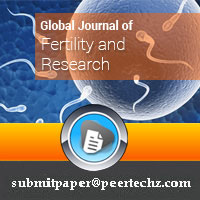Global Journal of Fertility and Research
Impacts of sugar and trans fat overconsumptions on development of polycystic ovary syndrome and female fertility
Sununta Youngwanichsetha*
Cite this as
Youngwanichsetha S (2020) Impacts of sugar and trans fat overconsumptions on development of polycystic ovary syndrome and female fertility. Glob J Fertil Res 5(1): 007-008. DOI: 10.17352/gjfr.000015Achievement of fertility is the expectation and desire of women in reproductive age. However, many women face sub-infertility or infertility. Overconsumption of foods and drinks containing sugar and trans fat are observed to be associated with female infertility. Sugar is commonly added in many sweetened drinks and desserts. Trans fat is ingredients of bakery and processed foods. Overconsumption of sugar and trans fat leading to obesity, metabolic syndrome and insulin resistance are known to be risk factors for developing of polycystic ovary syndrome (PCOS) and fertility problems among women [1]. In women with obesity, excess abdominal and visceral adipose tissues cause insulin resistance, hyperinsulinism, hyperandrogenism and PCOS [2]. This paper focuses on female fertility problems related to impacts of sugar and trans fat overconsumptions because of development of PCOS. Women worldwide have PCOS and infertility. The prevalence of PCOS among women in various population is 6.3-21% [3,4].
Prior research evidences reveal association of sugar and trans fat consumption and obesity, insulin resistance, hyperinsulinemia, and PCOS). Over intake of sugar and trans fat promote being growth of adipocyte and accumulation of adipose tissue. Adipocytes produces and secretes estrogen, fatty acid, cytokines that affect hypothalamic-pituitary axis, ovary and adrenal gland function including lower level of luteinizing and follicle-stimulating hormones leading to the development of PCOS [5]. Women with PCOS experience sub-infertility or infertility due to anovulation because of PCOS and its associated pathogenesis including hyperandrogenism, oligomenorrhea and amenorrhea [6].
Another study supports that dietary patterns have impact on risk of PCOS development. Women usually consume diets containing high carbohydrate, animal protein, fat, cholesterol, saturated fatty acids and others shows higher incidence of PCOS than those consuming vitamin and antioxidants from vegetables and fruits [7]. On the other hand, promotion of taking a low calories, low fat diets and high fiber would improve PCOS manifestations and reversible of ovulation and menstrual period [8].
Knowing and understanding of these risk factors would be helpful to prevent the development of polycystic ovary syndrome and infertility problems. Metabolic health literacy including healthy dietary pattern and avoiding unhealthy diets should be educated among women [9-11]. Limited and avoiding consumption of sugar and trans fat should be the focus of metabolic counseling. Clearly illustration of pathogenesis of polycystic ovary syndrome and its impact on female fertility would be informed and advised in order to build their awareness and recognition. As a result, reducing overconsumption of sugar and trans fat would be achieved. Hopefully, sub-infertility among women with obesity, insulin resistance, and PCOS would be improved. Finally, additional medical management of PCOS would enhance female fertility.
- Awlaqi AA, Alkhayat K, Hammadeh ME (2016) Metabolic syndrome and infertility in women. Int J Womens Health 4: 89-95. Link: https://bit.ly/3cfOzNG
- Zhang B, Wang J, Shen S, Liu J, Sun J, et al. (2018). Association of androgen excess with glucose intolerance in women with polycystic ovary syndrome. BioMed Research International 2018: 6869705. Link: https://bit.ly/2TPH4Hb
- Wolf WM, Wattick RA, Kinkade ON, Olfert MD (2018) Geographic prevalence of polycystic ovary syndrome as determined by region and race/ethnicity. Int J Environ Res Public Health 15: 2589. Link: https://bit.ly/3dgSyuP
- Mu L, Zhao Y, Li R, Lai Y, Chang HM, et al. (2018). Prevalence of polycystic ovary syndrome in metabolically healthy obese population. Int J Gynaecol Obstet 146: 164-169. Link: https://bit.ly/2XHstyl
- Rosenfield RL, Ehrmann DA (2016) The pathogenesis of polycystic ovary syndrome: the hypothesis of PCOS as functional ovarian hyperandrogenism revisited. Endocr Rev 37: 467-520. Link: https://bit.ly/3cgZc2O
- Dumesic DA, Oberfield SE, Stener-Victorin E, Marshall JC, Laven JS, et al. (2015). Scientific statement on the diagnostic criteria, epidemiology, pathophysiology, and molecular genetics of polycystic ovary syndrome. Endocr Rev 36: 487-525. Link: https://bit.ly/2ZLyhcY
- Eslamian G, Hekmatdoost A (2019) Nutrient patterns and risk of polycystic ovary syndrome. J Reprod Infertil 20: 161-168. Link: https://bit.ly/2AlM8fc
- Tripathi S, Singh M, Jain M, Khatoon S (2020) Nutritional perspective of polycystic ovary syndrome: A review study. Current Medicine Research and Practice 10: 65-69.
- Witchel SF, Oberfield SE, Pena AS (2019) Polycystic ovary syndrome: Pathophysiology, presentation, and treatment with emphasis on adolescent girls. J Endocr Soc 3: 1545-1573. Link: https://bit.ly/2ZMMaYh
- Lagana AS, Vitale SG, Noventa M, Vitagliano A (2018). Current management of polycystic ovary syndrome: From bench to bedside. International Journal of Endocrinology 2018: 7234543. Link: https://bit.ly/2TS7aZQ
- Lua ACY, et al. (2018). Managing polycystic ovary syndrome in primary care. Singapore Med J 59: 567-571. Link: https://bit.ly/3eyFy4a
Article Alerts
Subscribe to our articles alerts and stay tuned.
 This work is licensed under a Creative Commons Attribution 4.0 International License.
This work is licensed under a Creative Commons Attribution 4.0 International License.

 Save to Mendeley
Save to Mendeley
